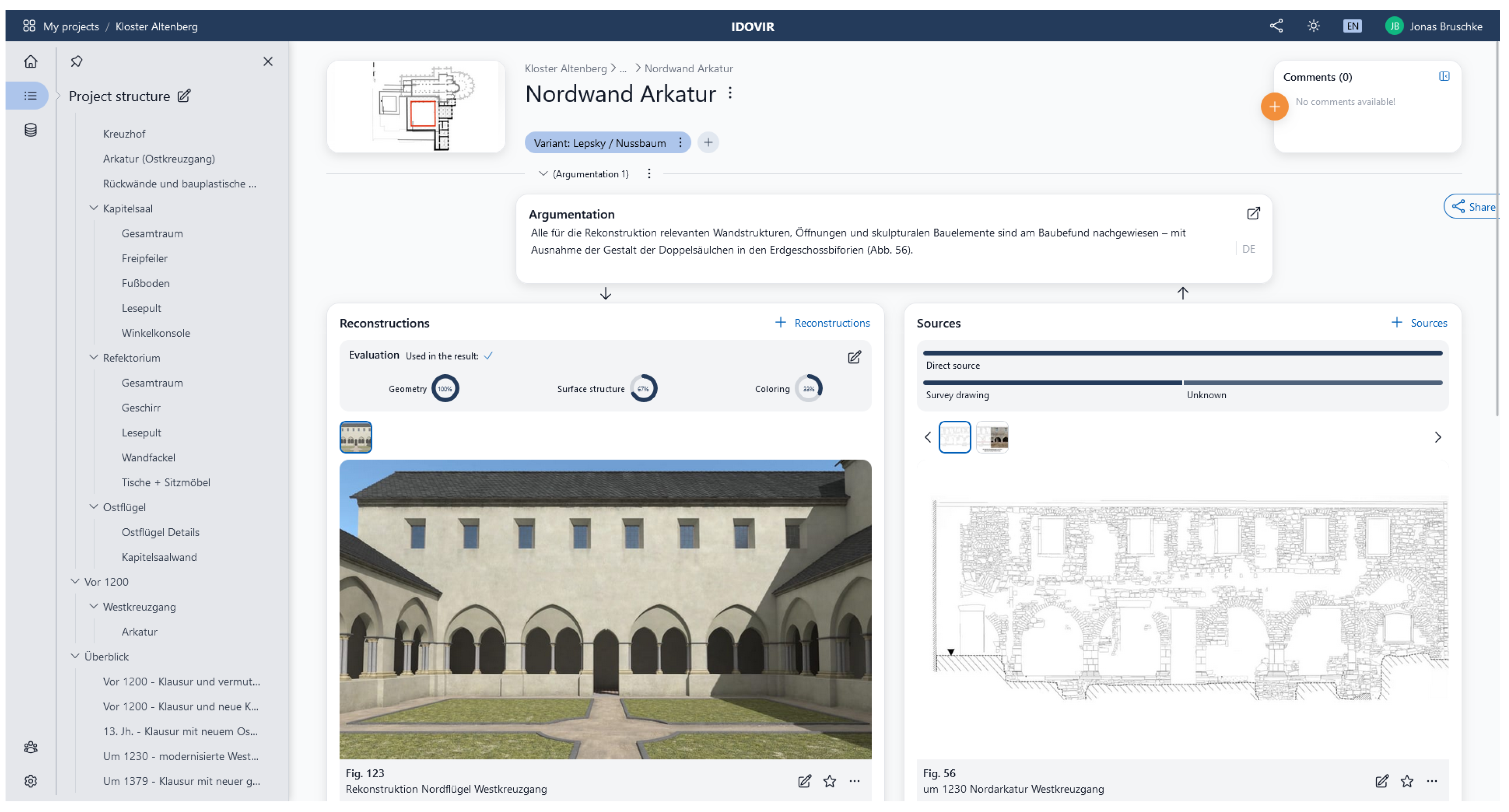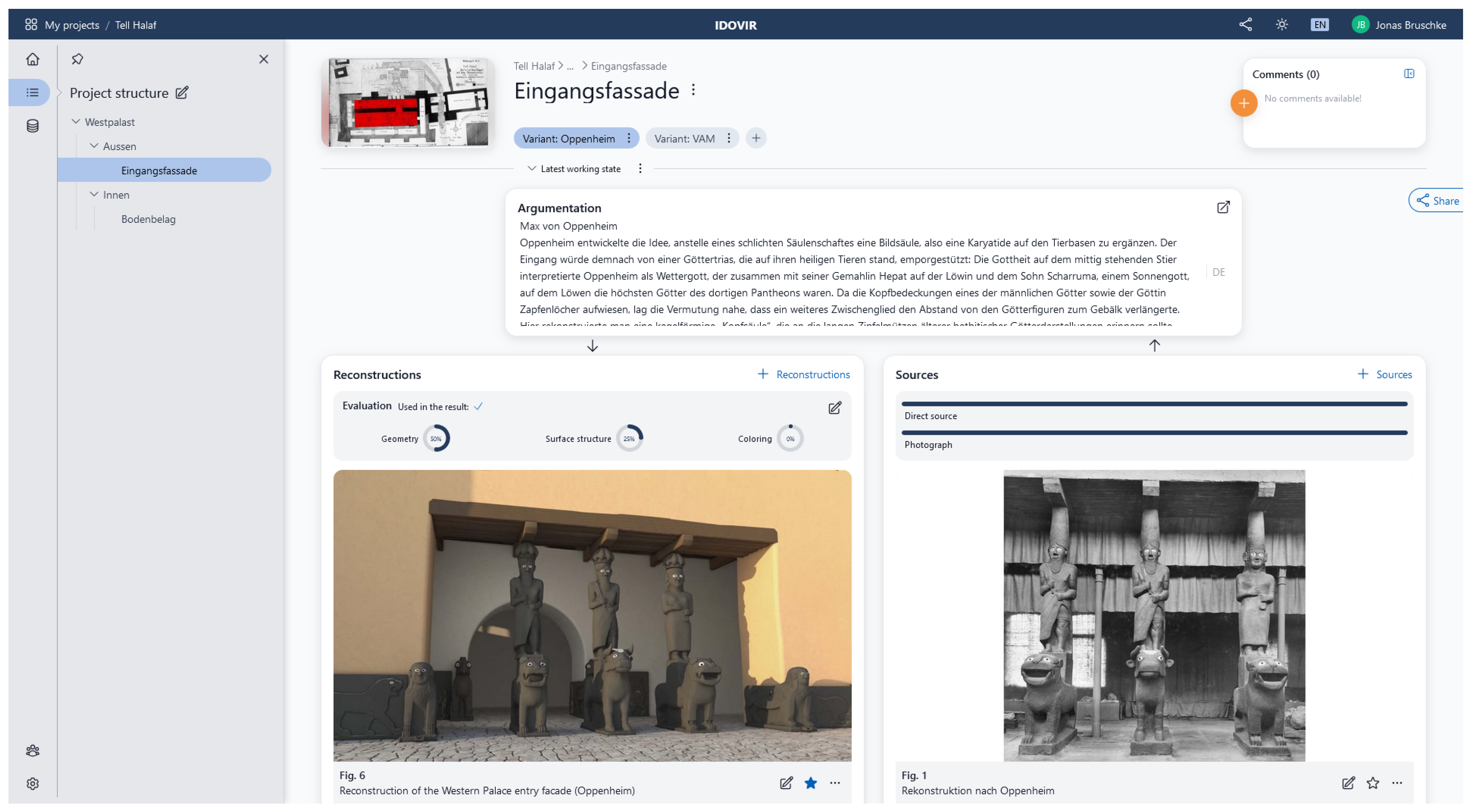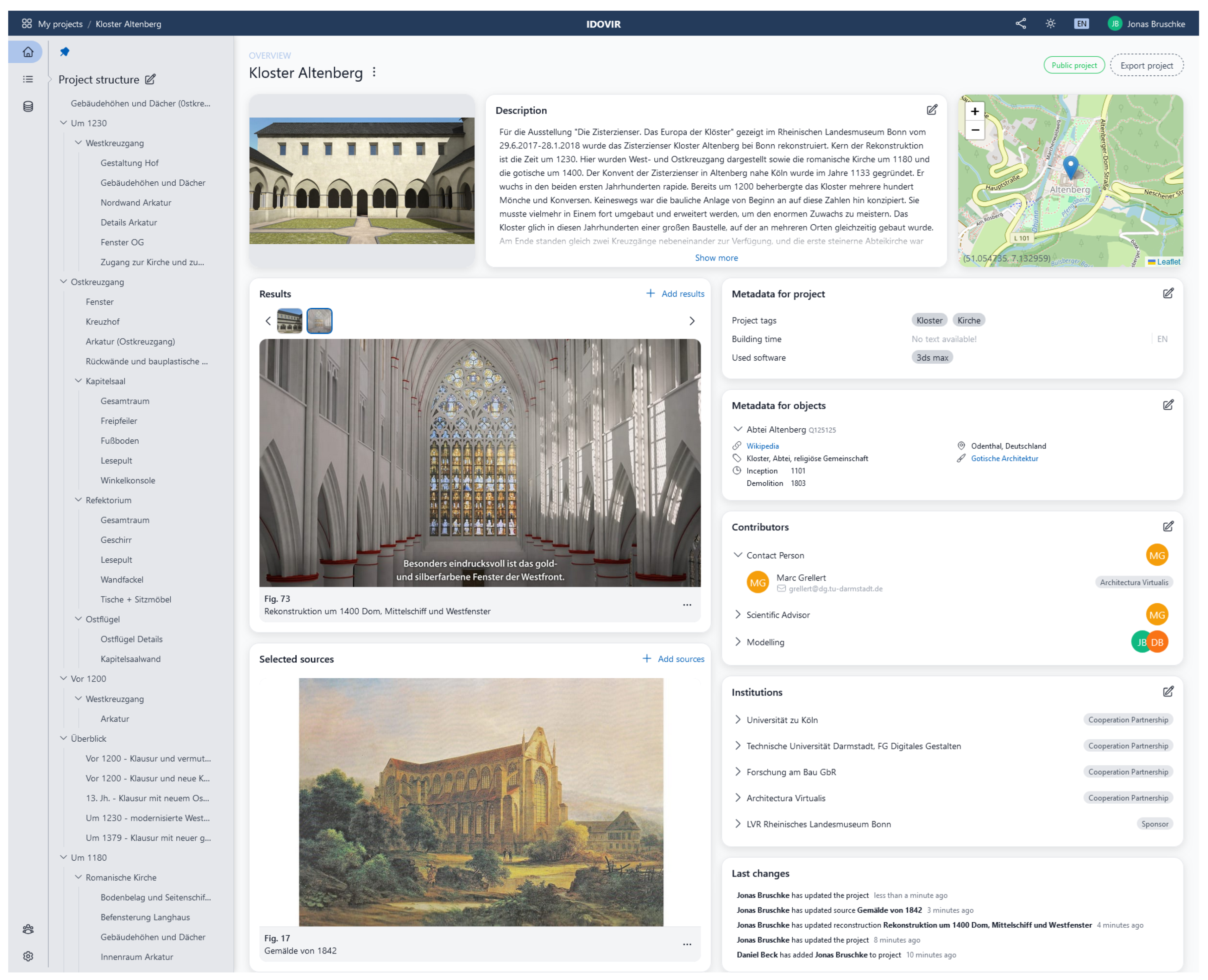IDOVIR—Infrastructure for Documentation of Virtual Reconstructions: Towards a Documentation Practice for Everyone
Abstract
1. Introduction
2. Past and Present Documentation Practice
2.1. The Issue of Scientific Documentation of Virtual Reconstructions
Documentation of the evaluative, analytical, deductive, interpretative, and creative decisions made in the course of computer-based visualization should be disseminated in such a way that the relationship between research sources, implicit knowledge, explicit reasoning, and visualization-based outcomes can be understood [3].
- Lack of funding requirements: Documentation is not typically mandated by funding bodies, nor are additional funds allocated specifically for it. Consequently, the responsibility for financing documentation often falls on the individuals and institutions involved in creating the reconstruction, resulting in higher workload.
- Lack of standards: There is no universal agreement on the standards, structure, and content of documentation. This lack of consensus complicates efforts to establish a consistent approach. Also, the interoperability and exchange of documentation data is not ensured.
- Limited tools and incentives: There are few established tools designed to support documentation in a way that users find valuable. Ideally, such tools should enhance and assist the reconstruction process through intelligent software support rather than being perceived as additional, cumbersome, and time-consuming tasks.
2.2. Documentation Approaches from Past to Present
2.3. Discussion
2.4. Beyond Existing Solutions
3. Towards a Shared Standard Documentation Tool
3.1. Objective
3.2. Spatio-Temporal Structure and Variants
3.3. Additional Features
- (a)
- Input option with minimal effort: Simplified input for users who require a basic, straightforward approach. Organizational structure templates help to channel the generated research data.
- (b)
- Guided data input with user-defined fields: Structured data entry with customizable fields to suit specific needs.
- (c)
- Two-dimensional representation: Upload of renderings of the virtual reconstruction for visualizing it in a 2D format.
- (d)
- Three-dimensional representation: Upload of 3D models that allow users to interactively explore the reconstruction in a three-dimensional space.
- (e)
- Evaluation tools: Various tools for assessing the model help to answer further research questions. This includes blending of 3D-oriented sources with the model, slicing the model to better gain insights into the interiors, and distance measurements within the 3D representation.
3.4. System Architecture
3.5. Metadata Standards
4. Closing Remarks
5. Outlook
- Increasing awareness and adoption: Efforts will be directed at promoting IDOVIR more widely within the professional community. This involves further user engagement to refine and adapt the platform based on their feedback and needs. In particular, more disciplines will be integrated into the design process of tools and workflows. IDOVIR strives to become part of the NFDI and to network with respective standardization groups. An integral part will be the integration of vocabularies and the mapping of data to CIDOC CRM, in order to foster interoperability with regard to the FAIR principles.
- Enhancing user experience: Building on the feedback collected in the first phase, which could not all be implemented within the project’s initial duration, the following steps will focus on improving user workflows. This includes integrating automated data entry, facilitating the use and transfer of publicly available data, developing additional tools tailored to different user groups, and applying AI techniques (e.g., for automatic detection of the category of a source). Special focus will be laid on collaborative features like precise local commenting tools on different levels (textual criticism, model criticism, source criticism, etc.) and on further exploit plausibility evaluation tools. Also, the visualization of different levels of plausibility is a wide field of research.
- Strengthening communication: The platform will be further integrated into the reconstruction process to minimize additional documentation-related workload. IDOVIR aims to make its use more compelling and integral during the reconstruction phase by streamlining communication and documentation tasks.
Author Contributions
Funding
Data Availability Statement
Conflicts of Interest
Abbreviations
| 3D | three-dimensional |
| AAT | Art & Architecture Thesaurus |
| BIM | Building Information Modeling |
| CI/CD | Continuous Integration and Continuous Delivery |
| CRM | Conceptual Reference Model |
| DDB | Deutsche Digitale Bibliothek (German Digital Library) |
| DFG | Deutsche Forschungsgemeinschaft (German Research Foundation) |
| EOSC | European Open Science Cloud |
| FAIR | Findable, Accessible, Interoperable, Re-usable |
| GND | Gemeinsame Normdatei (Integrated Authority File) |
| glTF | Graphics Library Transmission Format |
| LOD | Linked Open Data |
| NFDI | Nationale Forschungsdateninfrastruktur (National Research Data Infrastructure) |
| Portable Document Format | |
| RDF | Resource Description Framework |
| REST | Representational State Transfer |
| ULB | University and State Library Darmstadt |
References
- Münster, S. Interdisziplinäre Kooperation bei der Erstellung Geschichtswissenschaftlicher 3D-Modelle; Springer VS: Wiesbaden, Germany, 2016. [Google Scholar] [CrossRef]
- Münster, S.; Apollonio, F.I.; Blümel, I.; Fallavollita, F.; Foschi, R.; Grellert, M.; Ioannides, M.; Jahn, P.H.; Kurdiovsky, R.; Kuroczyński, P.; et al. Handbook of Digital 3D Reconstruction of Historical Architecture; Springer: Cham, Switzerland, 2024. [Google Scholar] [CrossRef]
- Denard, H. Implementing Best Practice in Cultural Heritage Visualisation: The London Charter. In Good Practice in Archaeological Diagnostics: Non-Invasive Survey of Complex Archaeological Sites; Corsi, C., Slapšak, B., Vermeulen, F., Eds.; Springer: Cham, Switzerland, 2013; pp. 255–268. [Google Scholar] [CrossRef]
- López-Menchero Bendicho, V.M. International Guidelines for Virtual Archaeology: The Seville Principles. In Good Practice in Archaeological Diagnostics: Non-Invasive Survey of Complex Archaeological Sites; Corsi, C., Slapšak, B., Vermeulen, F., Eds.; Springer: Cham, Switzerland, 2013; pp. 269–283. [Google Scholar] [CrossRef]
- Pfarr, M. Dokumentationssystem für Digitale Rekonstruktionen am Beispiel der Grabanlage Zhaoling, Provinz Shaanxi, China. Ph.D. Thesis, Technische Universität Darmstadt, Darmstadt, Germany, 2010. [Google Scholar]
- Arnold, D.; Geser, G. EPOCH Research Agenda for the Applications of ICT to Cultural Heritage—Full Report; Archaeolinga: Budapest, Hungary, 2008. [Google Scholar]
- Demetrescu, E.; Fanini, B. A white-box framework to oversee archaeological virtual reconstructions in space and time: Methods and tools. J. Archaeol. Sci. Rep. 2017, 14, 500–514. [Google Scholar] [CrossRef]
- Wacker, M.; Bruschke, J. Dokumentation von Digitalen Rekonstruktionsprojekten. In Der Modelle Tugend 2.0: Digitale 3D-Rekonstruktion als Virtueller Raum der Architekturhistorischen Forschung; Kuroczyński, P., Pfarr-Harfst, M., Münster, S., Eds.; Computing in Art and Architecture; ART-Books: Heidelberg, Germany, 2019; pp. 282–294. [Google Scholar] [CrossRef]
- Pletinckx, D. How to make Sustainable Visualizations of the Past: An EPOCH Common Infrastructure Tool for Interpretation Management. In Paradata and Transparency in Virtual Heritage; Bentkowska-Kafel, A., Denard, H., Baker, D., Eds.; Routledge: Farnham, UK, 2012; pp. 203–244. [Google Scholar]
- Bekiari, C.; Bruseker, G.; Doerr, M.; Ore, C.E.; Stead, S.; Velios, A. Definition of the CIDOC Conceptual Reference Model v7.1.1; The CIDOC Conceptual Reference Model Special Interest Group: Paris, France, 2021. [Google Scholar] [CrossRef]
- Doerr, M.; Theodoridou, M. CRMdig: A generic digital provenance model for scientific observation. In Proceedings of the TaPP’11, 3rd USENIX Workshop on the Theory and Practice of Provenance, Heraklion, Greece, 20–21 June 2011. [Google Scholar]
- Doerr, M.; Fafalios, P.; Stead, S. Definition of the CRMinf—An Extension of CIDOC CRM to Support Argumentation. Version 1.0. 2023. Available online: https://cidoc-crm.org/crminf/ModelVersion/version-1.0 (accessed on 4 August 2025).
- Guillem, A.; Zarnic, R.; Bruseker, G. Building an Argumentation Platform for 3D Reconstruction using CIDOC-CRM and Drupal. In Proceedings of the 2015 Digital Heritage, Granada, Spain, 28 September–2 October 2015; Volume 2, pp. 383–386. [Google Scholar] [CrossRef]
- Kuroczyński, P.; Hauck, O.; Dworak, D. 3D Models on Triple Paths—New Pathways for Documenting and Visualizing Virtual Reconstructions. In 3D Research Challenges in Cultural Heritage II: How to Manage Data and Knowledge Related to Interpretative Digital 3D Reconstructions of Cultural Heritage; Münster, S., Pfarr-Harfst, M., Kuroczyński, P., Ioannides, M., Eds.; Springer: Cham, Switzerland, 2016; pp. 149–172. [Google Scholar] [CrossRef]
- Kuroczyński, P.; Bajena, I.; Große, P.; Jara, K.; Wnęk, K. Digital Reconstruction of the New Synagogue in Breslau: New Approaches to Object-Oriented Research. In Research and Education in Urban History in the Age of Digital Libraries; Springer International Publishing: Cham, Switzerland, 2021; pp. 25–45. [Google Scholar] [CrossRef]
- Kuroczyński, P.; Brandt, J.; Jara, K.; Große, P. Historic Building Information Modeling (hBIM) und Linked Data—Neue Zugänge zum Forschungsgegenstand objektorientierter Fächer. In Proceedings of the DHd 2019 Digital Humanities: Multimedial & Multimodal, Frankfurt & Mainz, Germany, 25–29 March 2019; pp. 138–141. [Google Scholar]
- Martens, B.; Peter, H. Virtuelle Rekonstruktion—BIM als Rahmenbedingung für eine langfristige Nutzung von 3D-Gebäudemodellen. In Der Modelle Tugend 2.0: Digitale 3D-Rekonstruktion als Virtueller Raum der Architekturhistorischen Forschung; Kuroczyński, P., Pfarr-Harfst, M., Münster, S., Eds.; ART-Books: Heidelberg, Germany, 2019; pp. 313–328. [Google Scholar] [CrossRef]
- Stenzer, A.; Ehrlinger, C.; Schmid, M. Ansätze zur semantischen 3D-Repräsentation von Bauwerken in Datenbanken. In Der Modelle Tugend 2.0: Digitale 3D-Rekonstruktion als Virtueller Raum der Architekturhistorischen Forschung; Kuroczyński, P., Pfarr-Harfst, M., Münster, S., Eds.; ART-Books: Heidelberg, Germany, 2019; pp. 371–390. [Google Scholar] [CrossRef]
- Salzer, L.; Arera-Rütenik, T.; Stenzer, A. Semantic Topologies for Complex Medieval Buildings and their Annotation—Basic Considerations for the Description of Historic Architecture in the Semantic Web. In Proceedings of the 26th International Conference on Cultual Heritage and New Technologies (CHNT 26), Vienna, Austria, 2–4 November 2021. [Google Scholar]
- Demetrescu, E. Archaeological stratigraphy as a formal language for virtual reconstruction. Theory and practice. J. Archaeol. Sci. 2015, 57, 42–55. [Google Scholar] [CrossRef]
- Hauck, O.; Kuroczyński, P. Cultural Heritage Markup Language—How to Record and Preserve 3D Assests of Digital Reconstruction. In Proceedings of the 19th International Conference on Cultural Heritage and New Technologies (CHNT 19), Vienna, Austria, 3–5 November 2014. [Google Scholar]
- Niccolocci, F.; Hermon, S. A Fuzzy Logic Approach to Reliability in Archaeological Virtual Reconstruction. In Beyond the Artifact. Digital Interpretation of the Past, Proceedings of CAA2004, Prato, Italy, 13–17 April 2004; Niccolocci, F., Hermon, S., Eds.; Archaeolingua: Budapest, Hungary, 2010; pp. 28–35. [Google Scholar]
- Apollonio, F.I.; Fallavollita, F.; Foschi, R.; Smurra, R. Multi-Feature Uncertainty Analysis for Urban-Scale Hypothetical 3D Reconstructions: Piazza delle Erbe Case Study. Heritage 2024, 7, 476–498. [Google Scholar] [CrossRef]
- Kensek, K.M.; Swartz Dodd, L.; Cipolla, N. Fantastic reconstructions or reconstructions of the fantastic? Tracking and presenting ambiguity, alternatives, and documentation in virtual worlds. Autom. Constr. 2004, 13, 175–186. [Google Scholar] [CrossRef]
- Bajena, I.; Beck, C. 3D Infrastructure for Digital Reconstructions: What is DFG 3D-Viewer? In Build on Data/Auf Daten Bauen. Forschungsdaten in der Historischen Bauforschung und Denkmalpflege. Tagungsband zur Community-Tagung des DFG-Projekts baureka.online am 4. und 5. Mai 2023 an der Technischen Universität Berlin; Naujokat, A., Helas, S., Eds.; RWTH Aachen University: Aachen, Germany, 2024; pp. 94–99. [Google Scholar] [CrossRef]
- Bajena, I.P.; Apollonio, F.I.; Argasiński, K.; Fallavollita, F.; Foschi, R.; Franczuk, J.; Koszewski, K.; Kuroczyński, P.; Lutteroth, J. Documentation and Publication of Hypothetical Virtual 3D Reconstructions in the CoVHer Project. In 3D Research Challenges in Cultural Heritage V: Paradata, Metadata and Data in Digitisation; Ioannides, M., Baker, D., Agapiou, A., Siegkas, P., Eds.; Springer Nature: Cham, Switzerland, 2025; pp. 115–126. [Google Scholar] [CrossRef]
- Grellert, M.; Pfarr-Harfst, M. Die Rekonstruktion-Argument-Methode—Minimaler Dokumentationsstandard im Kontext digitaler Rekonstruktionen. In Der Modelle Tugend 2.0: Digitale 3D-Rekonstruktion als Virtueller Raum der Architekturhistorischen Forschung; Kuroczyński, P., Pfarr-Harfst, M., Münster, S., Eds.; ART-Books: Heidelberg, Germany, 2019; pp. 264–280. [Google Scholar] [CrossRef]
- Wilkinson, M.D.; Dumontier, M.; Aalbersberg, I.J.; Appleton, G.; Axton, M.; Baak, A.; Blomberg, N.; Boiten, J.W.; da Silva Santos, L.B.; Bourne, P.E.; et al. The FAIR Guiding Principles for scientific data management and stewardship. Sci. Data 2016, 3, 160018. [Google Scholar] [CrossRef] [PubMed]
- Harpring, P. Development of the Getty Vocabularies: AAT, TGN, ULAN, and CONA. Art Doc. J. Art Libr. Soc. N. Am. 2010, 29, 67–72. [Google Scholar] [CrossRef]
- Arndt, S.; Beer, A.; Blümel, I.; Elsner, C.; Hauschke, C.; Holste, D.; Kampe, B.; Lindlar, M.; Mofakhamsanie, G.; Noback, A.; et al. FID Civil Engineering, Architecture and Urbanism digital—A platform for science (BAUdigital). Res. Ideas Outcomes 2022, 8, e82563. [Google Scholar] [CrossRef]
- Grellert, M.; Wacker, M.; Bruschke, J.; Stille, W.; Beck, D. Documentation and Evaluation of Virtual Reconstructions. In Proceedings of the 2023 IMEKO International Conference on Metrology for Archaeology and Cultural Heritage, Rome, Italy, 19–21 October 2023; pp. 653–658. [Google Scholar] [CrossRef]





| Platform | Short Description | Evaluation |
|---|---|---|
| Pletinckx [9] | Proposed Wiki-based system. | Only theoretical approach. System is not accessible nor are any screenshots of a prototype available. |
| Guillem, Zarnic, and Bruseker [13] | Drupal-based implementation storing data in compliance with the CIDOC CRM and some extensions in a relational database. | Prototypical implementation for one use case that also included the documentation of the reasoning. Not accessible anymore. |
| Virtual Research Environment for digital 3D reconstructions [15] | WissKI-based platform with triple store based on CIDOC CRM and customized ontology. | The reconstructed building is divided into many sub-objects, each linked with the sources used, with neighboring objects, and with a research activity. However, each data entity has its own dedicated view, making it complex to navigate and to gather all necessary information. An overview of the object’s hierarchy is missing. It seems to remain a prototype, where each reconstruction project would require its own instance. |
| DFG-3D-Viewer [25] and CoVHer [26] | Repository approach, including the definition of a generally applicable metadata standard (prototypes built upon WissKI). | The tool only allows the submission of a completed 3D reconstruction followed by a comprehensive input form for metadata. References to sources used are possible, but the documentation of the reasoning can only be attached as arbitrary data. It also enables links to other platforms, from which 3D models can originate, thus serving as a kind of distributor. |
Disclaimer/Publisher’s Note: The statements, opinions and data contained in all publications are solely those of the individual author(s) and contributor(s) and not of MDPI and/or the editor(s). MDPI and/or the editor(s) disclaim responsibility for any injury to people or property resulting from any ideas, methods, instructions or products referred to in the content. |
© 2025 by the authors. Licensee MDPI, Basel, Switzerland. This article is an open access article distributed under the terms and conditions of the Creative Commons Attribution (CC BY) license (https://creativecommons.org/licenses/by/4.0/).
Share and Cite
Wacker, M.; Grellert, M.; Stille, W.; Bruschke, J.; Beck, D. IDOVIR—Infrastructure for Documentation of Virtual Reconstructions: Towards a Documentation Practice for Everyone. Heritage 2025, 8, 328. https://doi.org/10.3390/heritage8080328
Wacker M, Grellert M, Stille W, Bruschke J, Beck D. IDOVIR—Infrastructure for Documentation of Virtual Reconstructions: Towards a Documentation Practice for Everyone. Heritage. 2025; 8(8):328. https://doi.org/10.3390/heritage8080328
Chicago/Turabian StyleWacker, Markus, Marc Grellert, Wolfgang Stille, Jonas Bruschke, and Daniel Beck. 2025. "IDOVIR—Infrastructure for Documentation of Virtual Reconstructions: Towards a Documentation Practice for Everyone" Heritage 8, no. 8: 328. https://doi.org/10.3390/heritage8080328
APA StyleWacker, M., Grellert, M., Stille, W., Bruschke, J., & Beck, D. (2025). IDOVIR—Infrastructure for Documentation of Virtual Reconstructions: Towards a Documentation Practice for Everyone. Heritage, 8(8), 328. https://doi.org/10.3390/heritage8080328






